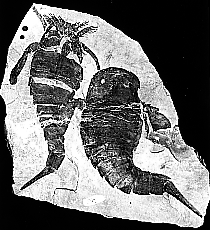







 There are more than 300 species of sea scorpions known. These have been
classified in more than 60 genera and about 20 families. Most major groups
can be recognized by the structure of the legs and chelicerae, but many
genera and species may only be recognized by structures on the ventral
(belly) side of the animal. For fossils in which only the dorsal (back)
side is visible, this means we cannot always identify them to species.
The fossil at right is a remarkable exception; two fossils of Eurypterus
were fossilized side-by-side showing both the dorsal and ventral aspect.
There are more than 300 species of sea scorpions known. These have been
classified in more than 60 genera and about 20 families. Most major groups
can be recognized by the structure of the legs and chelicerae, but many
genera and species may only be recognized by structures on the ventral
(belly) side of the animal. For fossils in which only the dorsal (back)
side is visible, this means we cannot always identify them to species.
The fossil at right is a remarkable exception; two fossils of Eurypterus
were fossilized side-by-side showing both the dorsal and ventral aspect.
The most recent complete revision of eurypterid classification was done by V.P. Tollerton, Jr., in 1989. He recognized a dozen superfamilies based on the morphology of the legs — whether they were spiny, similar in appearance, and whether the sixth pair of appendages were modified as paddles. He recognized two suborders, the Pterygotina with greatly enlarged pincer-like chelicerae and simple walking legs, and the Eurypterina in which the chelicerae are small and the forward legs are usually spiny.
Unfortunately, there are no published cladistic studies on the Eurypterida, and only a single unpublished thesis attempting to produce a phylogeny of all the taxa. It therefore remains uncertain which groups and what characters are truly primitive among sea scorpions.
Eurypterids are chelicerate arthropods, and until recently were put into the Class Merostomata with the Xiphosura (horseshoe crabs). It is now believed that the Eurypterida is the sister group to the Arachnida, making the sea scorpions closer relatives of the scorpions and spiders than to horseshoe crabs.
Jason Dunlop of the University of Manchester has reported finding slit-like structures and book lungs on some eurypterid fossils. Such structures are today known only in arachnids.
Photo taken by B. M. Waggoner. Fossil of Eurypterus is specimen 31472 in the UCMP Invertebrate Type Collection.
Sources:
